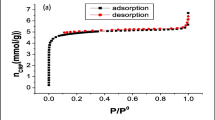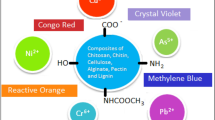Abstract
Perfluorooctane sulfonate (PFOS), as a potential persistent organic pollutant, has been widely detected in water environments, and has become a great concern in recent years. PFOS is very stable and difficult to decompose using conventional techniques. Sorption may be an attractive method to remove it from water. In this study, the molecularly imprinted polymer (MIP) adsorbents were prepared through the polymerization of 4-vinylpyridine under different preparation conditions in order to remove perfluorooctane sulfonate (PFOS) from water. The MIP adsorbents using perfluorooctanoic acid (PFOA) as the template had good imprinting effects and could selectively remove PFOS from aqueous solution. The sorption behaviors including sorption kinetics, isotherms, and effect of pH, salt, and competitive anions were investigated. Experimental results showed that the sorption of PFOS on the MIP adsorbents was very fast, pH-dependent, and highly selective. The achieved fast sorption equilibrium within 1 h was attributed to the surface sorption on the fine adsorbents. The sorption isotherms showed that the sorption selectivity of PFOS on the MIP adsorbents decreased at high PFOS concentrations, which may be due to the double-layer sorption and the formation of PFOS micelles on the sorbent surface. The sorption of PFOS on the MIP adsorbents was mainly dominated by the electrostatic interaction between the protonated vinylpyridine on the adsorbent surface and the anionic PFOS. The prepared MIP adsorbents can potentially be applied in water and wastewater treatment for selective removal of PFOS.
Similar content being viewed by others
References
Giesy J P, Kannan K. Perfluorochemical surfactants in the environment. Environmental Science and Technology, 2002, 36(7): 146A–152A
Sinclair E, Kannan K. Mass loading and fate of perfluoroalkyl surfactants in wastewater treatment plants. Environmental Science and Technology, 2006, 40(5): 1408–1414
Prevedouros K, Cousins I T, Buck R C, Korzeniowski S H. Sources, fate and transport of perfluorocarboxylates. Environmental Science and Technology, 2006, 40(1): 32–44
tVan de Vijver K I, Hoslbeek L, Das K, Blust R, Joiris C, De Coen W. Occurrence of perfluorooctane sulfonate and other perfluorinated alkylated substances in harbor porpoises from the Black Sea. Environmental Science and Technology, 2007, 41(1): 315–320
Nakata H, Kannan K, Nasu T, Cho H S, Sinclair E, Takemura A. Perfluorinated contaminants in sediments and aquatic organisms collected from shallow water and tidal flat areas of the Ariake Sea, Japan: Environmental fate of perfluorooctane sulfonate in aquatic ecosystems. Environmental Science and Technology, 2006, 40(16): 4916–4921
Skutlarek D, Exner M, Farber H. Perfluorinated surfactants in surface and drinking water. Environmental Science Pollution Research, 2006, 13(5): 299–307
Kannan K, Koistinen J, Beckmen K, Evans T, Gorzelany J F, Hansen K J, Jones P D, Helle E, Nyman M, Giesy J P. Accumulation of perfluorooctane sulfonate in marine mammals. Environmental Science and Technology, 2001, 35(8): 1593–1598
Giesy J P, Kannan K. Global distribution of perfluorooctane sulfonate in wildlife. Environmental Science and Technology, 2001, 35(7): 1339–1342
Fujii S, Polprasert C, Tanaka S, Lien N P H, Qiu Y. New POPs in the water environment: Distribution, bioaccumulation and treatment of perfluorinated compounds-a review paper. Journal of Water Supply Research and Technology-Aqua, 2007, 56(5): 313–326
UNEP Draft risk profile: perfluorooctane sulfonate (PFOS). http://www.unon.org/confss/doc/unep/pops/POPRC_02/POPRC.2_11/K0652253.pdf
Loos R, Locoro G, Huber T, Wollgast J, Christoph E H, De Jager A, Gawlik B M, Hanke G, Umlauf G, Zaldivar J M. Analysis of perfluorooctanoate (PFOA) and other perfluorinated compounds (PFCs) in the River Po watershed in N-Italy. Chemosphere, 2008, 71(2): 306–313
Sinclair E, Mayack D T, Roblee K, Yamashita N, Kannan K. Occurrence of perfluoroalkyl surfactants in water, fish, and birds from New York State. Archives of Environmental Contamination and Toxicology, 2006, 50(3): 398–410
Moody C A, Martin J W, Kwan W C, Muir D C G, Mabury S C. Monitoring perfluorinated surfactants in biota and surface water samples following an accidental release of firefighting foam into Etohicoke Creek. Environmental Science and Technology, 2002, 36(4): 545–551
Prevedouros K, Cousins I, Buck R C, Korzeniowski S H. Sources, fate and transport of perfluorocarboxyates. Environmental Science and Technology, 2006, 40(1): 32–44
Tang C Y Y, Fu Q S, Robertson A P, Criddle C S, Leckie J O. Use of reverse osmosis membranes to remove perfluorooctane sulfonate (PFOS) from semiconductor wastewater. Environmental Science and Technology, 2006, 40(23): 7343–7349
Yamamoto T, Noma Y, Sakai S I, Shibata Y. Photodegradation of perfluorooctane sulfonate by UV irradiation in water and alkaline 2-propanol. Environmental Science and Technology, 2007, 41(16): 5660–5665
Moriwaki H, Takagi Y, Tanaka M, Tsuruho K, Okitsu K, Maeda Y. Sonochemical decomposition of perfluorooctane sulfonate and perfluorooctanoic acid. Environmental Science and Technology, 2005, 39(9): 3388–3392
Hori H, Nagaoka Y, Yamamoto A, Sano T, Yamashita N, Taniyasu S, Kutsuna S, Osaka I, Arakawa R. Efficient decomposition of environmentally persistent perfluorooctane sulfonate and related fluorochemicals using zerovalent iron in subcritical water. Environmental Science and Technology, 2006, 40(3): 1049–1054
Tang C Y Y, Fu Q S, Criddle C S, Leckie J O. Effect of flux (transmembrane pressure) and membrane properties on fouling and rejection of reverse osmosis and nanofiltration membranes treating perfluorooctane sulfonate containing wastewater. Environmental Science and Technology, 2007, 41(6): 2008–2014
Tanaka S, Fujii S, Kimura K, Nozoe M, Qiu Y. Removal characteristics of PFOS and PFOA by granular and powder activated carbons in composite samples. Organohalogen Compounds, 2007, 69: 2820–2823
Schaefer A. Perfluorinated surfactants contaminate German waters. Environmental Science and Technology, 2006, 40(23): 7108–7109.
Yu Q, Zhang R Q, Deng S B, Huang J, Yu G. Sorption of perfluorooctane sulfonate and perfluorooctanoate on activated carbons and resin: Kinetic and isotherm study. Water Research, 2009, in press, doi:10.1016/j.watres.2008.12.001
Alexander C, Andersson H S, Andersson L I, Ansell R J, Kirsch N, Nicholls I A, O’Mahony J, Whitcombe M J. Molecular imprinting science and technology: a survey of the literature for the years up to and including 2003. Journal of Molecular Recognition, 2006, 19(2): 106–180
Meng Z, Chen W, Mulchandani A. Removal of estrogenic pollutants from contaminated water using molecularly imprinted polymers. Environmental Science and Technology, 2005, 39(22): 8958–8962
Yang K G, Liu Z B, Mao M, Zhang X H, Zhao C S, Nishi N. Molecularly imprinted polyethersulfone microspheres for the binding and recognition of bisphenol A. Analytica Chimica Acta. 2005, 546(1): 30–36
Yu Q, Deng S B, Yu G. Selective removal of perfluorooctane sulfonate from aqueous solution using chitosan-based molecularly imprinted polymer adsorbents. Water Research, 2008, 42(12): 3089–3097
Qi Y H, Zhang Q Y, Luo C C, Wang J, Xu L. Application of tree structured fingerprint to the prediction of pK(a) of pyridine derivatives. Chemical Journal Chinese Universities, 2004, 25(6): 1100–1103
Brooke D, Footitt A, Nwaogu T A. Environmental risk evaluation report: Perfluorooctane sulfonate (PFOS). UK Environment Agency, 2004
Kissa E. Fluorinated Surfactants and Repellents. 2nd ed. New York: Marcel Dekker, 2001
Johnson R L, Anschutz A J, Smolen J M, Simcik M F, Penn R L. The adsorption of perfluorooctane sulfonate onto sand, clay, and iron oxide surfaces. Journal of Chemical and Engineering Data, 2007, 52(4): 1165–1170
Higgins C P, Luthy R G. Sorption of perfluorinated surfactants on sediments. Environmental Science and Technology, 2006, 40(23): 7251–7256
Author information
Authors and Affiliations
Corresponding author
Rights and permissions
About this article
Cite this article
Deng, S., Shuai, D., Yu, Q. et al. Selective sorption of perfluorooctane sulfonate on molecularly imprinted polymer adsorbents. Front. Environ. Sci. Eng. China 3, 171–177 (2009). https://doi.org/10.1007/s11783-009-0017-4
Received:
Accepted:
Published:
Issue Date:
DOI: https://doi.org/10.1007/s11783-009-0017-4




